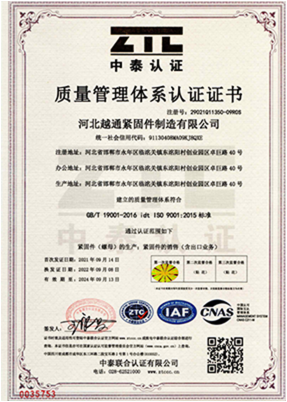юли . 27, 2024 11:10 Back to list
Exploring the Versatility and Applications of Carbon Steel Wedges in Various Industries
Understanding Carbon Steel Wedges Applications and Advantages
Carbon steel wedges are vital tools widely employed in various industries, ranging from construction to manufacturing. These specialized implements are designed to split, lift, or hold materials in place, showcasing the versatility and strength of carbon steel as a material.
What is Carbon Steel?
Carbon steel is an alloy primarily composed of iron and carbon, with carbon content typically ranging from 0.05% to 2.0%. This composition bestows carbon steel with remarkable strength, durability, and resistance to wear, making it an ideal choice for creating wedges. The properties of carbon steel can vary significantly depending on the amount of carbon present, which can dictate the hardness, ductility, and tensile strength of the steel, thereby influencing the performance of the wedges.
Design and Types of Carbon Steel Wedges
Carbon steel wedges come in various shapes and sizes, tailored for specific applications. Common types include splitting wedges, which are used to split logs and other materials, and lifting wedges, which assist in raising heavy objects. The design often features a tapered edge that allows for easy insertion into tight spaces, thus facilitating greater leverage and force application.
For instance, a splitting wedge features a broader and sharper edge, making it highly effective in felling trees or splitting wood. Conversely, a lifting wedge might have a more pronounced taper to aid in prying heavy equipment off the ground or repositioning large materials.
Applications in Various Industries
carbon steel wedge

The applications for carbon steel wedges are expansive, encompassing multiple fields
. In construction, they are crucial for aligning structures, allowing builders to make precise adjustments. In the logging industry, these wedges play a critical role in safely and efficiently felling trees, ensuring that the process is both effective and controlled.Manufacturers utilize carbon steel wedges in assembly lines, where they may be used to align components or disconnect parts during the assembly process. Additionally, blacksmiths and metalworkers frequently rely on these tools for shaping and manipulating hot metals.
Advantages of Using Carbon Steel Wedges
One of the most significant advantages of carbon steel wedges is their strength. The inherent properties of carbon steel enable the wedges to withstand heavy loads and repetitive use without deforming or breaking. This reliability is paramount, particularly in high-stakes environments such as construction sites or manufacturing plants.
Moreover, carbon steel has excellent wear resistance, meaning that these wedges can maintain their functionality over prolonged periods. With proper care and maintenance, they can serve many years without significant deterioration, making them a cost-effective investment.
Another benefit is the ease of sharpening and maintenance. Carbon steel can be honed to a sharp edge, maximizing efficacy in splitting or lifting tasks. Additionally, while carbon steel is prone to rust, proper treatment with protective coatings or regular oiling can prevent corrosion, thus prolonging the life of the wedges.
Conclusion
In conclusion, carbon steel wedges are indispensable tools that exemplify the strength and versatility of carbon steel. Their wide range of applications in various industries underscores their importance in day-to-day operations. By understanding the unique properties and advantages of carbon steel wedges, professionals can harness their capabilities to improve efficiency and productivity in their respective fields. Whether in construction, manufacturing, or woodworking, these wedges remain reliable allies in achieving precision and power in material handling.
-
The Ubiquitous Reach of DIN934 in Application Realms
NewsMay.16,2025
-
Exploring Different Bolt Types
NewsMay.16,2025
-
Cracking the Code of Sleeve Anchor Mastery
NewsMay.16,2025
-
Clamp Design Principles,Types and Innovations
NewsMay.16,2025
-
Artistry Inspired by the Humble Anchor Bolt
NewsMay.16,2025
-
A Deep Dive into Screw Types
NewsMay.16,2025


